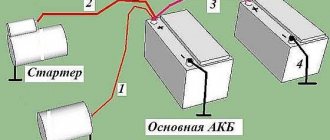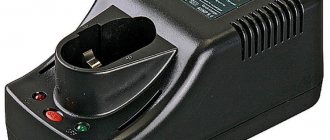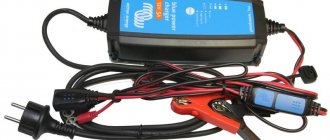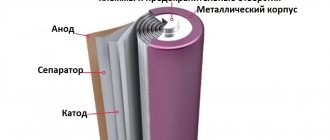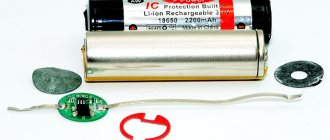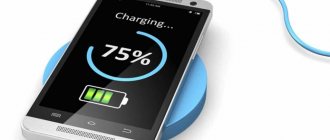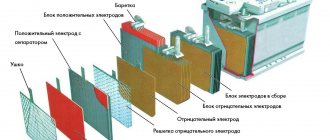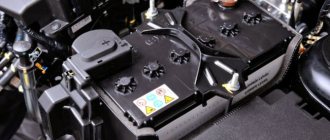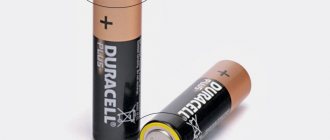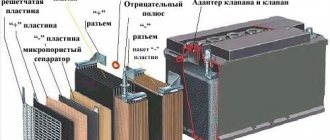It is difficult to find an area where there are no devices running on electrical energy. Mobile sources include rechargeable batteries and disposable batteries that power the consumer by converting chemical energy into electrical energy. Lithium-ion batteries are electron pairs with active components containing lithium salts. The shape of the battery resembles a disposable AA battery, but is slightly larger, has hundreds of charging cycles, and belongs to Li-ion 18650 batteries.
Li-ion battery 18650 device
The production of lithium-ion batteries is based on the sites of Sanyo, Sony, Panasonic, LG Chem, Samsung SDI, Skme, Moli, BAK, Lishen, ATL, HYB . Other companies buy elements, repackage them, passing them off as their own products. They also write false information about the product on the shrink film. There are currently no 18650 Li-ion batteries with a capacity higher than 3600 mAh.
The main difference between rechargeable batteries and batteries is the possibility of repeated recharging. All batteries are designed for a voltage of 1.5 V, the product has a li-ion output of 3.7 V. Form factor 18650 means a lithium battery 65 mm long, 18 mm in diameter.
18650 lithium battery operating mode characteristics:
- The maximum voltage is 4.2 V, and even minor overcharging significantly reduces the service life.
- The minimum voltage is 2.75 V. When reaching 2.5 V, special conditions for capacity restoration are required. When the voltage at the terminals is 2.0 V, the charge is not restored.
- The minimum operating temperature is -20 0 C. Charging at sub-zero temperatures is not possible.
- Maximum temperature +60 0 C. At higher temperatures, an explosion or fire can be expected.
- Capacity is measured in Amps/Hours. A fully charged 1Ah battery can supply 1A of current for an hour, 2A for 30 minutes, or 15A for 4 minutes.
Li-ion battery 18650 - a brief description of when created
The concept of lithium batteries itself appeared in 1970, when scientist Michael Whittenham demonstrated the possibility of combining titanium disulfide with lithium ions during battery discharge, and they were extracted during charging.
At that time, the voltage of such a battery was too low, and the fire hazard was incredibly high. This prompted D. Goodenough to create a new material called lithium cobaltite in 1980, and lithium ferrophosphate in 1996. The new batteries had a higher voltage.
What is now used as the lithium-ion battery first appeared in 1991. The battery was created by Akira Yoshino, and production was launched by Sony, with graphite as the anode and lithium cobaltite as the cathode. Three scientists who worked on the creation of lithium-ion batteries received the 2021 Nobel Prize in Chemistry.
Sony was the first to release a lithium-ion battery
Battery operating principle
The basis for the operation of a Li-ion battery is carbon material and the principle of so-called intercalation. The idea is to introduce lithium into the structure of the discharge electrode during the charging period of the battery. As a result, an intercalation compound is formed. During discharge, lithium leaves the crystalline carbon, giving up an electron.
Interesting! The safety of lithium-ion batteries has been improved by eliminating lithium metal and using its bound ions.
What does “18650” mean, size in mm
The size of lithium-ion batteries is indicated by a digital code. In the case of a 18650 battery, the meaning of the numbers is as follows:
- 18 – diameter;
- 65 – length;
- 0 – body shape – cylinder.
Important! With the same technical characteristics, but with installed protection, the battery will have different overall dimensions.
Its characteristics are written on the battery case.
Also, the name of the 18650 battery may contain letters; they may differ among different manufacturers, but there are some generally accepted designations between them:
- I – indicates that the battery is ion;
- C – cathode is made of cobalt;
- F – cathode material iron phosphate;
- M – the battery uses manganese;
- R – denotes, in fact, the battery itself.
Depending on the manufacturer, other symbols may be added to characterize the element; the marking of 18650 batteries will be different.
Where is the plus and minus
In an 18650 battery, it is very important not to confuse the polarity. Understanding where the plus and minus of an 18650 battery is located is not as difficult as it might seem at first glance. Yes, both sides are similar at first glance, but they have a rather significant difference - the positive terminal has up to four small holes and still protrudes slightly, compared to the completely flat negative terminal.
It is not difficult to distinguish the polarity
Charge controller for li-ion battery 18650
Major manufacturers produce standard 18650 lithium batteries without a protective board. This controller, made in the form of an electronic circuit, is installed on top of the case, lengthening it somewhat. The board is located in front of the negative terminal and protects the battery from short circuits, overcharging, and overdischarging. Defense is being assembled in China. There are devices of good quality, but there are outright scams - unreliable information, capacity 9,000A/h. After installing the protection, the case is placed in shrink film with inscriptions. Due to the additional design, the case becomes longer and thicker, and may not fit into the intended slot. Its standard size can be 18700, and can be increased due to additional actions. If the 18650 battery is used to create a 12V battery that has a common charge controller, breakers on the individual Li-ion cells are not needed.
The purpose of protection is to ensure the operation of the energy source within the specified parameters. When charging with a simple charger, the protection will not allow overcharging and will turn off the power in time if the 18650 lithium battery runs down to a voltage of 2.7 V.
18650 battery with protection, what is it
To ensure greater safety, manufacturers began to integrate a special electronic board into the battery case, designed to protect against overheating and rupture of the shell. The charge voltage is regulated, and the discharge of the element is also controlled. Whether you purchased an 18650 battery with or without protection, let’s look at how to determine this.
Battery with protection is slightly larger than usual
How to determine whether it is protected or not
It is not difficult to determine the presence of protection in a 18650 lithium battery; as a rule, the manufacturer indicates this on the body of the element itself. Also, when compared with a conventional Li-ion battery, a slight increase in the case is detected, usually no more than 2 mm.
Reference! On batteries with protection you can see the inscription - protected, with protected PCB or protection circuit; unprotected batteries can be produced without additional comments or marked unprotected.
Do you need battery protection?
The voltage applied to the battery when charging it significantly affects the life of the element. The protection blocks charging if the voltage is exceeded or decreased excessively while the battery is being recharged. This ensures longer battery life and safer use.
Marking of lithium batteries 18650
There are markings on the surface of the battery case. Here you can find complete information about the technical properties. In addition to the manufacturing date, expiration date and manufacturer's brand, the device of 18650 lithium batteries and the consumer qualities associated with this aspect are encrypted.
- ICR – lithium-cobalt cathode. The battery has a high capacity, but is designed for low current consumption. Used in laptops, video cameras and similar long-lasting equipment with low energy consumption.
- IMR – lithium manganese cathode. It has the ability to produce high currents and can withstand discharge up to 2.5 a/h.
- INR – nickelate cathode. Provides high currents, withstands discharge up to 2.5 V.
- NCR is a specific marking of Panasonic. The properties of the battery are identical to the IMR. Nickelates, cobalt salts, and aluminum oxide are used.
Positions 2,3,4 are called “high-current”, they are used for flashlights, binoculars, and cameras.
Lithium ferrophosphate batteries have the ability to operate at deep minus temperatures and are restored during deep discharge. Undervalued on the market.
By the marking you can determine whether this is a rechargeable lithium battery with the letters I R. If there are letters C/M/F, the cathode material is known. The capacity indicated will be mA/h. The release date and expiration date are located in different places.
You should know that manufacturers of rechargeable lithium batteries do not have products with a capacity of more than 3,600 mAh. In order to repair a laptop battery or assemble a new one, you need to purchase batteries without protection. To use a single copy, you need to buy elements with protection.
How to test a 18650 lithium battery
If, when buying an expensive device, you doubt the veracity of the information on the case, there are ways to check. In addition to special meters, you can use improvised means.
- You have a charger, you can time the time of full charging with a certain current strength. The product of time and current will reveal the approximate capacity of the li-ion battery.
- A smart charger will help you. It will show both voltage and capacity, but the device is expensive.
- Connect the flashlight, measure the current, and wait for the light to go out. The product of time and current gives the current capacity in A/h.
You can determine the power of a battery by weight: a 18650 lithium battery with a capacity of 2000 mAh should weigh 40 g. The higher the capacity, the greater the weight. But the defectors have learned to add sand to the body to make it heavier.
Charger for 18650 lithium batteries
Lithium batteries are demanding on terminal voltage parameters. The maximum voltage is 4.2 V, the minimum is 2.7 V. Therefore, the charger works as a voltage stabilizer, creating 5 V at the output.
The determining indicators are the charging current and the number of elements in the battery, which you set yourself. Each element (jar) must receive a full charge. Power is distributed using a balancer circuit for 18650 lithium batteries. The balancer can be built-in or manually controlled. Good memory is expensive. Anyone who understands electrical circuits and knows how to solder can make a charger for li-ion with their own hands.
The proposed do-it-yourself charger circuit for 18650 lithium batteries is simple and will turn off the consumer after charging on its own. The cost of components is about 4 dollars, not a shortage. The device is reliable, will not overheat and will not catch fire.
Charger circuit for lithium 18650 batteries
In a homemade charger, the current in the circuit is regulated by resistor R4. The resistance is selected so that the initial current depends on the capacity of the 18650 lithium battery. What current should be used to charge a li-ion battery if its capacity is 2,000 mAh? 0.5 - 1.0 C will be 1-2 amperes. This is the charging current.
Lithium batteries - what does the user need to know?
Cylindrical Li-ion batteries are now becoming increasingly popular. They are used in flashlights, toys, airsoft equipment and electronic cigarettes. In the article we will reveal the most common questions that buyers and users ask technical specialists of TM ROBITON.
Variety of lithium batteries
There are currently 5 types of lithium batteries that are popular and widely used. They differ in the cathode material - these are oxides of cobalt, manganese, nickel-manganese-cobalt, iron phosphate, aluminum. Depending on the cathode composition, batteries have different characteristics, the main ones of which are given in the comparative table:
| ICR | INR | IMR | NCR | IFR | |
| Cathode material | LiCoO2 "LCO" | Li(NiCoMn)O2 "NCM" | LiMn2O4 "LMO" | Li(NiCoAl)O2 "NCA" | LiFePO4 "LFP" |
| Temperature safety | 150*С | 210*С | 250*С | 150*С | 270*С |
| Current output | 1C | 1C, 2C | 10C (long term) -30C (5s) | 1C | 25C (continuously) – 40C (2s) |
| Cycles | 500 — 1000 | 1000 — 2000 | 300 — 700 | >500 | 1000-2000 |
| Max charge current | 0.7, 1C | 0.7, 1C | 0.7, 1С, 3С | 0.7С | 1С-4С |
| Maximum voltage | 4.25V | 4.25V, 4.35V | 4.25V | 4.25V | 3.65V |
| Rated voltage | 3.6V, 3.7V | 3.6V, 3.7V | 3.6V, 3.7V, 3.8V | 3.6V | 3.2V, 3.3V |
| Minimum voltage | 2.5V, 2.75V | 2.5V | 2.5V, up to 2.0V allowed | 2.5V, 2.75V | 2.0V |
The assortment of the ROBITON brand includes lithium batteries of all 5 types.
Protection board: protected and unprotected batteries
Li-ion batteries are sensitive to deep discharge, as well as to overcharging and maximum current, the values of which should not be exceeded. It is quite problematic for the user to comply with all the conditions. For example, if the battery is used in a flashlight, the battery can easily be damaged by forgetting to turn off the flashlight and subjecting the battery to a deep discharge. They are also extremely sensitive to the final charge voltage. That's why there are batteries with a protective board. It will automatically disconnect the jar from the consumer when the minimum voltage is reached, when the maximum current is exceeded, or when the maximum voltage is reached. The presence of a protective board is relevant for nickel-cobalt batteries; nickel-manganese IMR batteries do not require a protective board.
Important parameters are current output, voltage and number of cycles.
Current output, as well as charging current, are usually expressed through “C” - battery capacity. For example, if a battery has a maximum current output of 2C, then for a battery with a capacity of 2500mAh this is 5A (2*2500).
High current IMR batteries
Batteries that can deliver currents of 2C or more are usually called “high current”. High-current IMR batteries can not only deliver high currents while maintaining a stable voltage, but also typically have “safe chemistry,” which means they are explosion- and fire-resistant when exposed to significant heat*. Such batteries have a lower capacity and shorter lifespan than batteries with “traditional” chemistry and are usually not equipped with a protective board. If an assembly is made from high-current IMR batteries, then a common protection board is installed on the assembly, which protects the batteries from deep discharge and overcharging.
*Temperature safety is the maximum temperature at which the battery will not explode, burn, or deform.
The operating temperature at which the battery retains its characteristics is, as a rule, much lower and averages 60*C.
Nominal voltage 3.6V and 3.7V.
The rated voltage for lithium batteries is the voltage at the midpoint of discharge after a 20-hour discharge (see graph). For most batteries, this voltage is 3.6V or 3.7V. There is no significant difference between batteries with a voltage of 3.6V and 3.7V when operating in most devices.
The number of cycles
Another important characteristic is the number of charge/discharge cycles. Most often, the “number of cycles” refers to the number after which the battery capacity drops below 80% of the initial capacity. After this, the battery, of course, does not “die”, but continues to work, but its capacity and maximum current decrease in value.
The number of cycles is usually indicated for certain conditions: charge current 0.2C, discharge current 0.2C, room temperature. If the battery is operated at currents of 1C or higher (which is not uncommon), or at a temperature other than room temperature, then the number of life cycles will be lower.
Charge
Lithium batteries must be charged using the CC-CV method - first with constant current, then with constant voltage. If at the charging stage with constant voltage you exceed it by only 4%, then the batteries will lose capacity twice as fast from cycle to cycle. Therefore, it is important to use special automatic chargers for lithium batteries.
Storage
Batteries are self-discharging, meaning that when stored they lose their charge at a certain rate. Optimal storage conditions are: temperature 0*C and charge level 40%.
This is why batteries leave production charged by 40%, while the battery voltage without load is at the level of 3.7-4.0V.
Lithium batteries age even when not used. After 2 years of storage, the battery irreversibly (not to be confused with self-discharge) loses approximately 20% of its capacity.
It follows from this that there is no need to buy a battery “in reserve” or get too carried away with saving.
Battery Manufacturers
The world's major battery manufacturers such as Panasonic, Samsung, LG and Sony do not produce them as a finished product for retail, but supply them as components to other manufacturers. Some of these manufacturers add their own protective board, some just stick a film on top with their brand and sell it as their product - the battery.
Conscientious manufacturers of finished batteries, such as ROBITON, use banks from trusted manufacturers, and also check all parameters before assembling the battery or repackaging it - they reject old batteries and indicate the actual measured capacity on their label.
What current to charge a li-ion battery 18650
There is a procedure for restoring the functionality of a 18650 lithium battery after the voltage drops to working voltage. We restore capacity measured in amp hours. Therefore, first we connect the Li-ion battery form factor 18650 to the charger, then we set the charging current with our own hands. The voltage changes over time, the initial value is 0.5 V. As a stabilizer, the charger is designed for 5 V. To maintain performance, parameters of 40-80% of the capacity are considered favorable.
The charging scheme for a li-ion 18650 battery involves 2 stages. First, you need to raise the voltage at the poles to 4.2 V, then stabilize the capacitance by gradually reducing the current. The charge is considered complete if the current drops to 5-7 mA when the power is turned off. The entire charging cycle should not exceed 3 hours.
The simplest single-slot Chinese charger for li-ion 18650 batteries is designed for a charging current of 1 A. But you will have to monitor the process yourself, switch it yourself. Universal chargers are expensive, but they have a display and carry out the process independently.
How to properly charge a Li-ion 18650 battery in a laptop? Connecting a set of energy sources in the gadget via Pover Bank. The battery can be charged from the mains, but it is important to turn off the power as soon as the unit has reached capacity.
Charging
Many buyers of various electrical equipment are interested in how to charge a 18650 Li-Ion battery (3.7V, 6800mah). This process is carried out using a special device. It starts charging at a voltage of 0.05 V, and ends at a maximum level of 4.2 V. The battery of this type cannot be charged above this value.
You can charge 18650 batteries with a current of 0.5-1A. The larger it is, the faster the process goes. However, a smoother current is preferable. It is better not to speed up the charging process if the battery is not needed urgently.
The procedure takes no more than 3 hours. After this, the device will turn off the battery. This prevents it from overheating and failure. There are charging devices on sale that cannot control the progress of this process. In this case, the user must monitor its implementation himself. Experts recommend purchasing devices that control the process themselves. This is a safe method.
Restoring li-ion battery 18650
If the battery refuses to work, it may manifest itself as follows:
- The energy source is quickly discharged.
- The battery is dead and won't charge at all.
Any source can quickly discharge if the capacity is lost. This is precisely why overcharge and deep discharge are dangerous, from which protection is provided. But there is no escape from natural aging, when storage in a warehouse annually reduces the capacity of the cans. There are no methods of regeneration, only replacement.
What to do if the battery does not charge after a deep discharge? How to restore li-ion 18650? After the controller disconnects the battery, it still has a reserve of energy capable of delivering 2.8-2.4 V voltage at the poles. But the charger does not recognize a charge up to 3.0V; anything lower is zero. Is it possible to wake up the battery and start the chemical reaction again? What needs to be done to increase the charge of li-ion 18650 to 3.1 -3.3V? You need to use a way to “push” the battery, give it the necessary charge.
Without going into calculations, use the proposed circuit, mounting it with a 62 Ohm resistor (0.5 W). A 5V power supply is used here.
If the resistor heats up, the lithium battery is zero, which means there is a short circuit or the protection module is faulty.
How to restore a 18650 lithium battery using a universal charger? Set the charge current to 10 mA, and perform precharging as written in the instructions for the device. After raising the voltage to 3.1 V, charge in 2 stages according to the SONY scheme.
